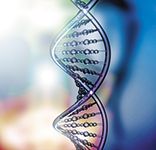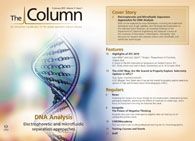Electrophoretic and Microfluidic Separation Approaches for DNA Analysis
DNA can be analyzed by many techniques, including electrophoretic techniques such as gel, capillary, and microchip electrophoresis. In this interview Kevin Dorfman, an Associate Professor in the Department of Chemical Engineering and Materials Science at the University of Minnesota in Minneapolis, Minnesota, USA, discusses his research with polymer physics and microfluidic and nanofluidic technologies.
Pages 2-5
DNA can be analyzed by many techniques, including electrophoretic techniques such as gel, capillary, and microchip electrophoresis, and nanochannel methods in which DNA is labelled and stretched. This interview with Kevin Dorfman, an Associate Professor in the Department of Chemical Engineering and Materials Science at the University of Minnesota in Minneapolis, Minnesota, USA, discusses his research with polymer physics and microfluidic and nanofluidic technologies. Specifically, his group studies the dynamics of DNA in confined systems using fluorescence microscopy and nanofabrication. He is recognized as a leader in the area of electrophoretic techniques for DNA separations, and is the recipient of the 2014 AES Mid-Career Award, which is given for exceptional contributions to the electrophoresis, microfluidics, and related areas by an individual who is currently in the middle of his or her career.
Q. A recent extensive review paper of yours1 covers the various techniques for obtaining sequence information directly from unamplified genomic-length DNA, including gel, capillary, and microchip electrophoresis; microfluidic separation methods; DNA stretching techniques; and fluorescence burst analysis. Which of these techniques are employed in your laboratory, and what types of information do they provide?
A: We work on both the electrophoresis and the nanochannel methods, using a combination of experiments and simulations. Since I was a postdoc, I have been interested in the microfluidic separation methods for long DNA. This was the major focus of my research group through 2012. Since that time, my research interests have shifted more towards stretching in nanochannels while we finish up some remaining projects in electrophoresis. In both cases, we are trying to improve technologies for obtaining genomic information at large scales - that is, at the level of genes rather than individual bases. In addition to providing genomic information, these are fantastic systems to explore the fundamentals of polymer physics and transport phenomena in well-controlled environments. I have not worked in the fluorescence burst analysis area. One of the reasons that I wanted to write this review paper was to have the opportunity to sit down and read that body of literature very carefully. The Los Alamos group did some amazing things with fluorescence burst analysis that I did not really appreciate until I got into the details.

Kevin Dorfman
Q. How complementary is this information?
A: In the electrophoretic method, which is older, the DNA is cut by restriction enzymes that recognize particular sequences. When these fragments are separated by size, you can figure out the genomic distance between each of the cutting sites. In the nanochannel method, the DNA is labelled with sequence specific probes and stretched. The location of the probes is read optically. In both cases you obtain a "fingerprint" of the DNA by either looking at the pattern of the separated DNA (for electrophoresis) or the location of the probes (for the nanochannels). The resolution of the methods is lower than DNA sequencing, on the order of a kilobase, but the ability to work with large, unamplified DNA is an advantage.

(PHOTO CREDIT: MINA DE LA O/GETTY IMAGES)
Q. What are the relative advantages of each of these techniques?
A: The electrophoretic methods are standard, and it is possible to get good results using pulsed-field gel electrophoresis in any biology laboratory. However, pulsed-field gel electrophoresis is limited by the challenge of reassembling the fragments into their genomic order, the amount of DNA you need to get a good signal, and the time required for the separation. The work done by my group and others, most notably the Baba group in Japan2,3 and the Viovy group in France,4,5 has reduced the separation time from many hours to minutes or even seconds by using microdevices. Since microdevices are small and use sensitive detection methods, they have improved the sample consumption problem. However, electrophoretic methods are always going to be limited by the need to cut the DNA first, separate it by size, and then figure out how those sizes were generated from the original genome. This last problem is solved by the various stretching methods such as nanochannel confinement; the DNA is not cut so you can see the order of each of the probes as well as the distance between them. Needless to say, working with single molecules of DNA in nanochannels is the ultimate limit in reducing the sample size.
Q. Electrophoretic methods have been considered the standard methods for DNA research. Have the other methods been developed to the point where they could have an impact outside of the analytical chemistry community?
A: The microchip methods are mature, but they have only had limited commercialization so far and those devices that have been commercialized focus on separating short fragments. At the moment, the microchip electrophoresis methods for long DNA are not really available outside the analytical chemistry community. A major reason for this lack of commercialization is that the stretching methods are starting to come to market, and look to be very promising. OpGen has been doing the surface stretching method for quite some time, and they have a number of impressive results for mapping organisms. BioNano Genomics, a startup company in San Diego, has been working to commercialize the nanochannel methods and their machines are now available for sale. They have also been publishing genomic data in the open literature, similar to OpGen, which I think is a critical step for getting outside the analytical chemistry community and having an impact in biology. The flow cytometry methods discussed in my review paper1 were developed to a high degree at Los Alamos National Lab, but unfortunately the group is no longer active in the area.
Q. How are Brownian dynamics and Monte Carlo simulation techniques used in your laboratory with electrophoresis and nanochannel methods? What information is obtained by using these simulation techniques?
A: These simulation techniques are complementary to the experimental work and provide different insights. The Monte Carlo simulations allow us to efficiently study equilibrium properties, while the Brownian dynamics simulations give us information about the DNA trajectories, both at equilibrium and out of equilibrium. Compared to the experiments, the simulations allow us to have a much higher spatial resolution since we are not limited by diffraction. We can also more easily "redesign" the microfluidic device in the simulation by just changing some of the parameters, such as the distance between the posts. If we see something that looks promising in the simulations, then we can invest the time and money to fabricate it and see if the prediction was correct. In both types of simulations, it is critical to have a model that is parameterized so that the simulation predictions are in agreement with experiments. We have worked extensively on this topic and the models we have for electrophoresis and nanochannel confinement make predictions about the separation and stretching that are quite close to what we see in the experiments.
Q. Are the various arrays and nanochannel devices used in your group's research all fabricated in your laboratory? If so, how did you learn the necessary fabrication techniques?
A: For the arrays, we learned everything by reading papers in the literature, talking to other people in the area, and most importantly using the expertise of the staff at the Minnesota Nano Center (MNC). The MNC is a fantastic resource, and we are particularly indebted to Mark Fisher and Tony Whipple for their expertise and advice, and to Prof. Steve Campbell for running such a user-friendly facility. All of the electrophoresis devices were fabricated in the MNC. For the nanochannels, we have been collaborating with Walter Reisner (assistant professor in the Department of Physics at McGill University) for the device fabrication. He made the first devices for us, and he helped to debug some of the problems that we were having with fabricating our own devices.
Q. What are the next steps in your research?
A: I see my research in this area moving even more towards the nanochannel project. We have done a lot of work to engineer the electrophoretic separation systems, but we have reached the point of diminishing returns with research into separation-based methods. In contrast, there are lots of great questions to answer about nanochannel stretching. For the moment, we are very focused on the physics of the nanochannel confinement itself. I think the next steps are to figure out how to improve the process of loading the DNA into the channels and whether the nanochannel technology can be integrated with upstream sample preparation or further downstream analysis. Interestingly, the loading problem requires understanding even more complicated electrophoretic problems in post arrays than the ones we have studied so far, so I think all of the work that we did in electrophoresis will prove useful here. We have two grants right now in collaboration with BioNano Genomics, so I also see us putting some of our effort towards very practical problems in the technology translation.
References
1. K.D. Dorfman, S.B. King, D.W. Olson, J.D.P. Thomas, and D.R. Tree, Chemical Reviews 113, 2584–2667 (2013).
2. N. Kaji et al., Anal. Chem. 76(1), 15–22 (2004).
3. T. Yasui et al., Microfluidics and Nanofluidics14(6), 961–967 (2013).
4. P. Doyle et al., Science 295(5563), 2237 (2002).
5. N. Minc et al., Anal. Chem. 76(13), 3770–3776 (2004).
Kevin Dorfman is an Associate Professor in the Department of Chemical Engineering and Materials Science at the University of Minnesota in Minneapolis, Minnesota, USA.
E-mail: dorfman@umn.edu
Website: https://www.cems.umn.edu/about/people/faculty.id20586.html
This article is from The Column. The full issue can be found here>>

Common Challenges in Nitrosamine Analysis: An LCGC International Peer Exchange
April 15th 2025A recent roundtable discussion featuring Aloka Srinivasan of Raaha, Mayank Bhanti of the United States Pharmacopeia (USP), and Amber Burch of Purisys discussed the challenges surrounding nitrosamine analysis in pharmaceuticals.
Silvia Radenkovic on Building Connections in the Scientific Community
April 11th 2025In the second part of our conversation with Silvia Radenkovic, she shares insights into her involvement in scientific organizations and offers advice for young scientists looking to engage more in scientific organizations.

.png&w=3840&q=75)

.png&w=3840&q=75)



.png&w=3840&q=75)



.png&w=3840&q=75)








